
| WWT Shows | CLICK TO: Join and Support Internet Horology Club 185™ | IHC185™ Forums |

|
• Check Out Our... • • TWO Book Offer! • |
Welcome Aboard IHC185™  Internet Horology Club 185
Internet Horology Club 185  IHC185™ Discussion Site Main Page
IHC185™ Discussion Site Main Page  Horological Discussions, Questions and Answers
Horological Discussions, Questions and Answers  Pocket Watch Discussions
Pocket Watch Discussions  Hairlines - Which Dials Are More Susceptible?
Hairlines - Which Dials Are More Susceptible?
 Internet Horology Club 185
Internet Horology Club 185  IHC185™ Discussion Site Main Page
IHC185™ Discussion Site Main Page  Horological Discussions, Questions and Answers
Horological Discussions, Questions and Answers  Pocket Watch Discussions
Pocket Watch Discussions  Hairlines - Which Dials Are More Susceptible?
Hairlines - Which Dials Are More Susceptible?Go  | New Topic  | Find-Or-Search  | Notify  | Tools  | Reply to Post  |  |
We have talked about your opinions of hairlines. Phil D said he thought Illinois Sante Fe Specials and Illinois Burlington seem to have fragile dials, possibly thinner procelain. Charlie said with 18 Size Bunn Specials, usually a hairline is found at the sub-second dial. Kevin stated using improper tools to remove dials coult result in hairlines. It seems colored fancy dials are most susceptible to hairlines. Maybe I notice them more so as I'm always on a search for them and see the hairlines. Which dials are more susceptible to hairlines and why? Stephanie O'Neil NAWCC Member 143979 | |||
|
| Watch Repair Expert |
I rather suspect we encounter hairlines more frequently on desirable dials primarily because the ones without the hairlines have found their way into well-established collections already, and seldom hit the open market anymore. Essentially, that leaves the rest of us circulating the less desirable ones. That said, it seems to me that Rockford Wind Indicator dials are more problematic than any other that readily come to mind. Since I like those watches, I tend to notice them, and of the 40 or 50 I've seen in my life, I don't think I've seen more than two or three with perfect dials. Of course, there again, my observations are probably biased because the watches I've seen have been in the market, and may not necessarily be representative of all existing examples. Remember, the conclusions we all draw today come from observing the watches that are currently in circulation. We really have no idea what sort of stuff exists in private collections, and it's possible that the stuff that's been removed from the market today, may actually be more prevalent than the stuff that's left. =============================== Steve Maddox President, NAWCC Chapter #62 North Little Rock, Arkansas IHC Charter Member 49 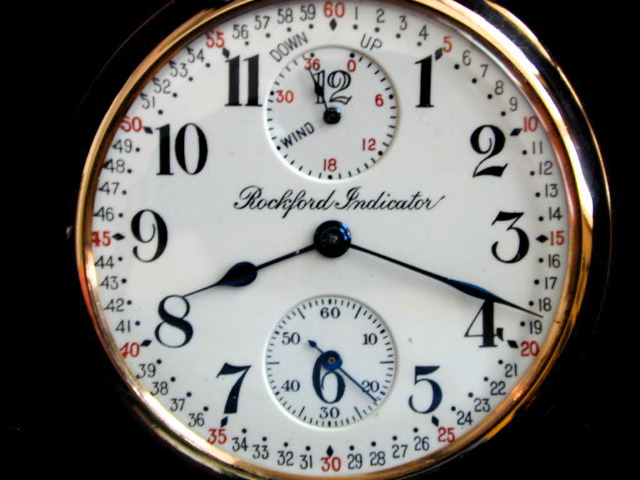 | |||
|
Steve has a very good point - the more collected a given watch model is, the more likely the perfect dials are already taken. Those switchers at it again ! Charlie | ||||
|
O pinion again... ALL dials are susceptible...... I agree with Steve on the Rockford indicator dials.... Rockford dials in general seem to be found with hairlines..... Good points are made on the "perfect" squirreled away dials.... | ||||
|
| Life Achievement Military Expert |
this squirrel will not give up his perfect dials!” | |||
|
| IHC Member 155 Bulova Watchmaker |
I agree with just about everything said above. The fancy dails cannot be cleaned to hide the hairlines so they do stand out more if there is a problem. The hunt for a perfect dial will always go on and on Rich Kuhn NAWCC 128623 IHC Member 155 | |||
|
| IHC Life Member |
Some are just thinner than others. On the left, Hampden. This seems a typical thickness of most dials I've looked at. On the right, Seth Thomas. Very thin. I don't know if this would have any effect though. IHC Member 25 IHC Life Member (L6) 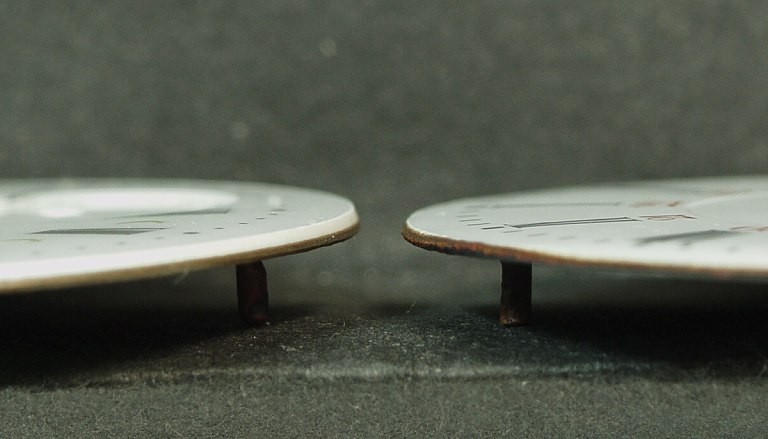 | |||
|
| IHC Life Member |
faces IHC Member 25 IHC Life Member (L6) 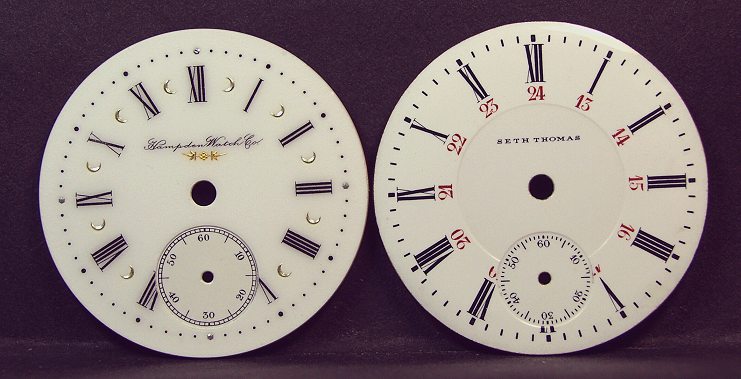 | |||
|
| IHC President Life Member |
WOW!!! Larry, you really made that one clear, the S-T in your picture looks positively fragile! Rich Kuhn's comment about our being unable to "soak-out" hairlines in colored dials is one I had not previously considered. Rich is right, there's no hiding the flaws in fancy dials! Another point on colored dials is the multiple trips to the oven for the layers of decoration to be built-up may also cause them to be more brittle. Charlie's comment on "switchers" brings to mind something I find interesting. Recently some of us observed quite a uproar regarding re-casing of watch movements. I was struck by the fact those who so vociferously and even viciously decry re-casing are the same ones who brag the loudest about having large collections of dials. Steve, those Rockford Indicator dials are among the all-time greats... and of course the RG 655 movement's no slouch either! | |||
|
Larry’s photos are really interesting! Not only is the Hampden thicker; its edge is so much more finely finished – smoothed and chamfered. How did they do it? Do Hamiltons, Walthams, Elgins look like this Hampden? Is there a difference among grades within a given maker? This is good stuff! | ||||
|
Waltham painted dial edge. 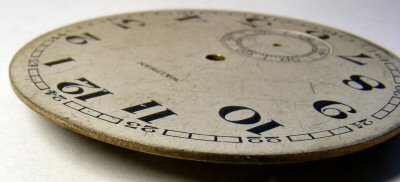 | ||||
|
Waltham dial porcelain. 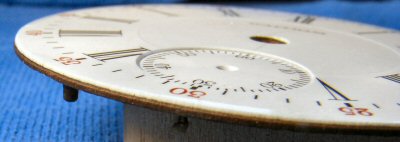 | ||||
|
| Watch Repair Expert |
When enamel is hot, it essentially becomes a viscous liquid, with all the flow properties pertaining thereto. When the liquid encounters a surface irregularity (such as the edge of the dial or a dial foot), surface tension draws the enamel upward or downward for a short distance. I don't imagine many people will have the foggiest idea what I'm talking about, but perhaps the sketch below will help explain it. The copper bases upon which most porcelain dials are fired, are relatively thin. Of the overall thickness of the dial, the copper portion seldom composes more than 10 to 20%. To prevent the enamel from drawing thin near the holes, those are cut last, after the enamel is finished, and to prevent it from drawing thin near the edge, a "lip" is formed around the perimeter. By looking at such a dial from the edge, it's easy to get the impression that the copper is much thicker than it is, but that's only at the edge. Again, the sketch below should be much more explanatory than words. In figure "A," a cheap dial is shown in cross section. Note how the copper base is flat, and how the enamel has receded near the edge, thereby leaving a thin curved portion at the perimeter. In figure "B," however, the lip around the perimeter of the copper base allows the hot enamel to flow up the edge, thereby taking advantage of the surface tension to create a dial surface that's almost perfectly flat. In figure "C," a hole is shown which was drilled before the dial was fired; again, the enamel has receded from the edges of the hole, thereby leaving a surface that isn't flat. Many porcelain dials on cheap watches (Ingersoll Reliance models, etc.) have this characteristic. Finally, note how the enamel tends to "gather" around the dial feet; again, this is the result of simple surface tension. ============================= SM | |||
|
Steve am I correct that none of the sketches resembles the profile of Larry’s Hampden? How was it produced? | ||||
|
Here is a Waltham dial that I believe matches Figure B in Steve Maddox's drawing. Its an early model 16size dial. 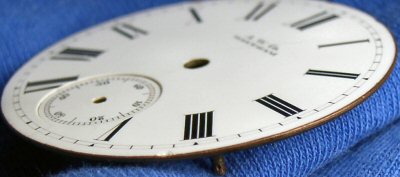 | ||||
|
| Watch Repair Expert |
Dog -- I honestly don't know how the Hampden dial in Larry's images above was produced, but it's apparent that the perimeter has been "ground" to finished size. That was a common practice, but I don't have a dial like it here that's suitable to be destroyed in order to find out how it was made. One reason that particular dial thicker than most is probably because it's a "glass enamel" dial, which is essentially a porcelain dial with a clear coat of glass over the top. That's how the metallic crescent-shaped pieces show through, yet are not raised above the dial's surface. Other reasons some dials are thicker around the edge is due to the various "sunk" sections. Obviously, in order to create a double-sunk dial in which all three sections are level on the back, the outer ring has to be thicker than the center, and the center has to be thicker than the seconds register. It's hard to tell for sure about Larry's ST dial, but it looks like a "pseudo double-sunk" dial, which is essentially just a single-sunk dial with a ground circular part in the middle to create the appearance of being "double-sunk." Wayne -- The dial in your image does match illustration "B" in the sketch above. If you'll closely examine the chip in the edge near the 21 minute mark, you should be able to see the raised rim of the copper base that I mentioned. ========================= | |||
|
Steve M., I would think sooner or later (barring heirs lack of interest) those desirable dials in well-established collections will hit the market. What's in circulation and what's not is a time-frame thing. What's in private collections could very well be hairlines on beautiful watches, pending on collectors standards at the time of purchase. Charlie, Thanks Terry H., From reading a number of comments from active collectors here at the site, I would say the same; ALL dials are susceptible. Greg C, Go Greg!!! Rich K., I would suppose fancy dials could not be cleaned because of color(fading) & guilding motif & decorations? Thanks for your comments. Larry S., Interesting to show pics and thickness of dials. Technique in making dials, poured or coated possibly? Thanks Larry. Lindell, Thanks for pointing out that multiple trips to the oven for the layers of decoration built-up can possibly cause brittle dials. Not to worry, no switching of dials here. There are colored dials and then complete watches with colored dials in my collection that will stay on their designated watch! Stu, Thanks for your comments Wayne C. Thanks for the comparison in pics. Steve M., Thanks for the detailed explanation with illustrations with regard to porcelain dials. Stephanie O'Neil NAWCC Member 143979 | ||||
|
| Powered by Social Strata |
| Your request is being processed... |
|
Welcome Aboard IHC185™  Internet Horology Club 185
Internet Horology Club 185  IHC185™ Discussion Site Main Page
IHC185™ Discussion Site Main Page  Horological Discussions, Questions and Answers
Horological Discussions, Questions and Answers  Pocket Watch Discussions
Pocket Watch Discussions  Hairlines - Which Dials Are More Susceptible?
Hairlines - Which Dials Are More Susceptible?
 Internet Horology Club 185
Internet Horology Club 185  IHC185™ Discussion Site Main Page
IHC185™ Discussion Site Main Page  Horological Discussions, Questions and Answers
Horological Discussions, Questions and Answers  Pocket Watch Discussions
Pocket Watch Discussions  Hairlines - Which Dials Are More Susceptible?
Hairlines - Which Dials Are More Susceptible?©2002-2025 Internet Horology Club 185™ - Lindell V. Riddle President - All Rights Reserved Worldwide

